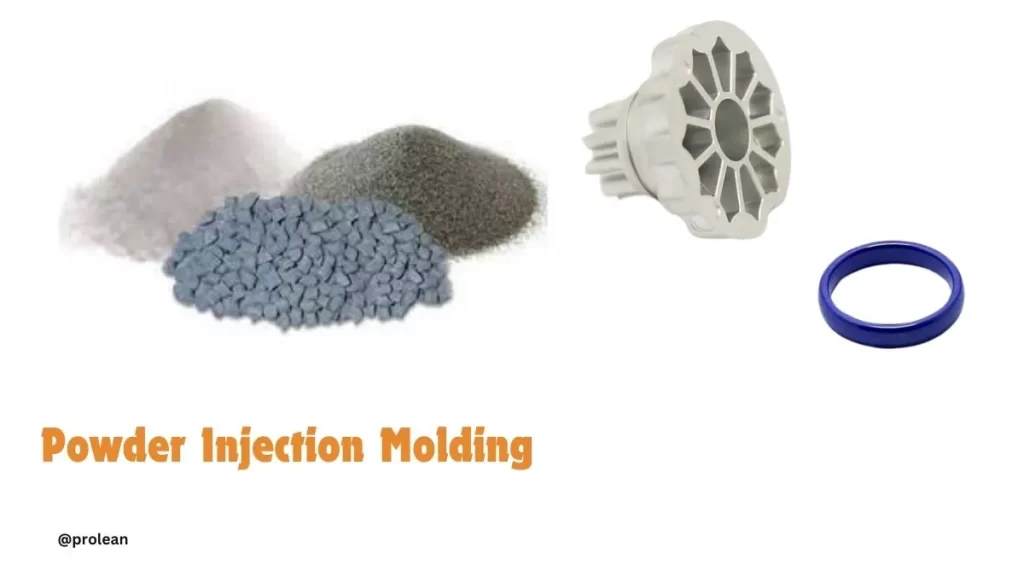
The powder Injection Molding process is halfway between polymer molding and powder metallurgy. PIM incorporates high-technology sintering methods that apply to ceramics and metals. The intended technique guarantees improved efficiency in the production of functional parts in large quantities. The flexibility of product information management corresponds to the demands of the contemporary industrial market. Let’s discuss critical aspects of the PIM process.
PIM: Innovative Evolution of Powder Injection Molding
Manufacturing Techniques in today’s fast-moving contemporary market change dynamically. Powder injection molding has emerged as an efficient fabrication technique. Polymer injection and powder metallurgy together give unequaled component tolerance. It is used on many materials but mainly on metals and ceramics. It has evolved into an essential technology in the manufacturing of accurate components. Many industries use PIM for components with complicated shapes and high performance.
Try Prolean Now!
What Is Powder Injection Molding (PIM)?
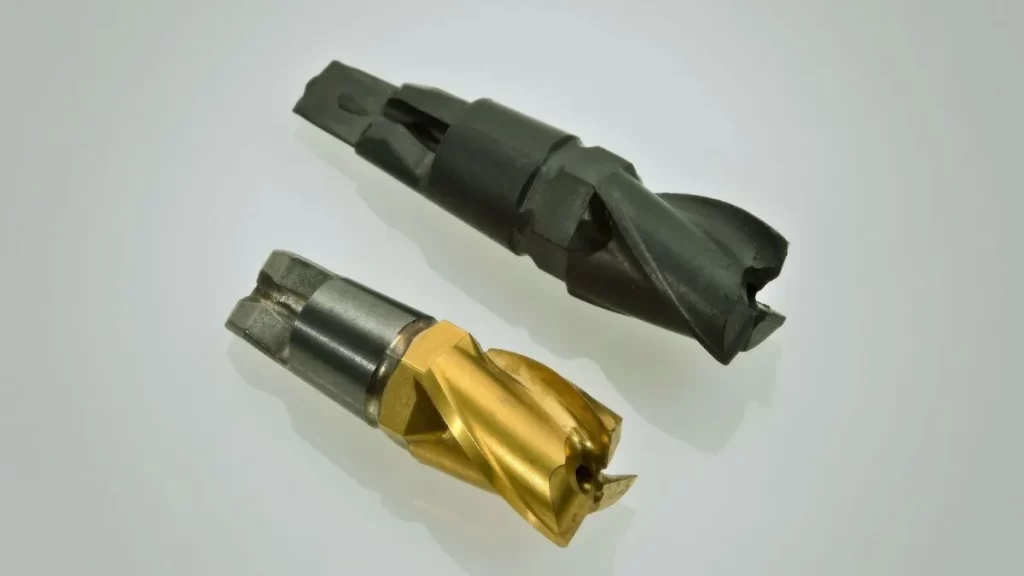
PIM fabrication
Powder injection molding (PIM) proves to be an improved manufacturing technique. The process encompasses metal or ceramic powder mixed with thermoplastic binders. It developed from the conventional polymer injection techniques but extended beyond them. Thus, the PIM forms complex shapes by incorporating additional sintering steps from powder metallurgy. They enable the production of Metal Injection Molding (MIM), and ceramic injection molding (CIM). The process is well suited for narrow tolerances but in high volume. Through the use of PIM, complex component shapes are easily formed, which greatly improves the quality of the products being made.
Technological Benefits of Powder Injection Molding
Powder Injection Molding has technological benefits over conventional methods. Its main advantage is in the manufacturing of components with intricate structures. PIM is well-suitable for manufacturing high-volume metallic and ceramic components. Moreover, it’s broadly helpful for complex functional parts in various sectors. Advantages of manufacturing include high material utilization, minimization of wastes, and high-quality products. One of the largest benefits of using PIM in the contemporary market is that it provides reliable results in large production runs.
Powder Injection Molding-PIM Process: Four Critical Stages
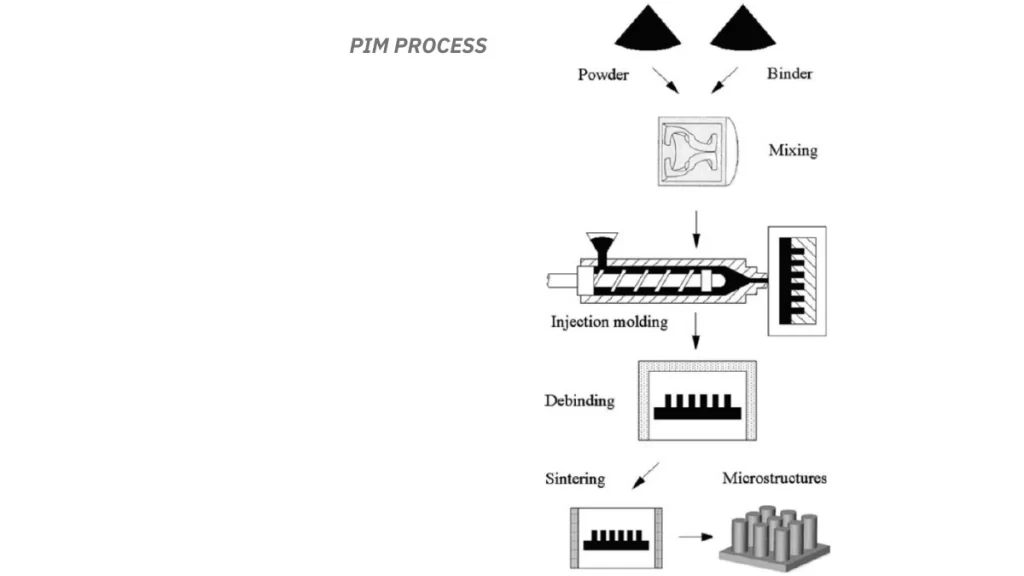
PIM Process
Powder Injection Molding consists of four main stages, combining polymer injection techniques with powder metallurgy processes:
- Feedstock Preparation
The process begins with the production of a material, referred to as the feedstock. This mix is normally composed of finely divided metal or ceramic particles and thermoplastic binders. The end product is a moldable material with the properties of the chosen powder. This means that the final part has to be made of the required feedstock characteristics for it to meet its intended application.
- Injection Molding of the Feedstock
The feedstock is then pumped into a helical feed barrel and then heated. When the pressure is controlled, the heated mixture is poured into a mold cavity. The feedstock gets shaped according to the mold, which provides the shape of the geometry of the component. When the molded material has come to room temperature, the produced shape is called the “green part.”
- Debinding: The Binder in the Green Part
The debinding process helps remove the binder used in molding. This step can be done by thermal treatment or solvent extraction. In both techniques, the thermoplastic binder is either decomposed or converted to vapor and gas, and a porous structure is created. The outcome of the process is called the “brown part” which is a preliminary product of the final solidified component.
- Sintering: Solidifying the Component
In the sintering process, the brown part is exposed to heat at planned temperatures. The material is heated near the melting point of the material to make the particles stick together. This process enhances the density of the component and also raises its overall density. The material shrinks by 15-20%. Sintering helps make the final product conform to the desired standards, and also have the right form of structure.
Material Selection in Powder Injection Molding
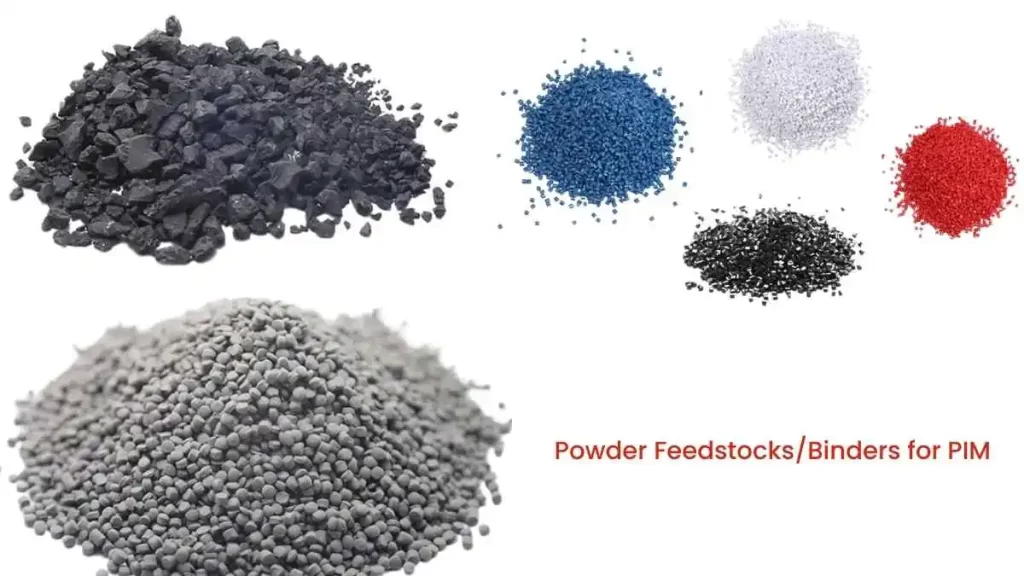
Powder feedstocks for the PIM Process
Powder Injection Molding (PIM) is a combination of the established powder metallurgy and ceramic processing techniques. This is an advantage since manufacturers can apprehend different types of materials. From fine metal or ceramic powders, the powders can be mixed for a particular characteristic such as high strength or corrosion resistance. A thermoplastic binder enables the powder to become sufficiently fluid during molding, which is why even complex pieces can be made. This utility provides high design flexibility in the case of a wide range of industries.
The following table outlines typical materials and their respective applications in PIM:
| Material Type | Example Materials | Typical Applications |
| Metals | Stainless Steels: 316L, 17-4 PH, 304L | Surgical instruments, automotive parts |
| Tool Steels: M2, D2 | Cutting tools, wear-resistant components | |
| Low-Alloy Steels: Fe-2%Ni, Fe-8%Ni | Structural parts, automotive components | |
| Soft Magnetic Alloys: Fe-Ni, Fe-Si | Electromagnetic shielding, inductors | |
| Titanium Alloys: Ti-6Al-4V | Aerospace components, medical implants | |
| Superalloys: Inconel 718, Inconel 625 | Aerospace and gas turbine components | |
| Tungsten Alloys: W-Ni-Fe, W-Ni-Cu | Radiation shielding, darts, counterweights | |
| Ceramics | Alumina (Al₂O₃) | Electrical insulators, wear-resistant components |
| Zirconia (ZrO₂) | Dental crowns, industrial cutting tools | |
| Silicon Nitride (Si₃N₄) | Engine components, high-performance cutting tools | |
| Silicon Carbide (SiC) | Wear plates, seal rings |
Try Prolean Now!
Market Prospectus of Powder Injection Molding (PIM)
Powder Injection Molding (PIM) has drastically changed. It has moved from the research and development stages into the production sectors in the electronics, computing, medical devices, and chemicals industries. It is expected injection molding companies will expand at a massive growth rate of between 20-40% in the years to come. With current global sales standing at $200 million. Market shares are led by the US which produces about 40% of total PIM parts while Japan comes second with 30%. Europe, which was more reluctant to take to the product initially, now accounts for about 15% of the market. The current statistics show that the U.S. has twice as many PIM companies as Europe, depicting great growth potential.
Applicability of the Powder Injection Molding Process
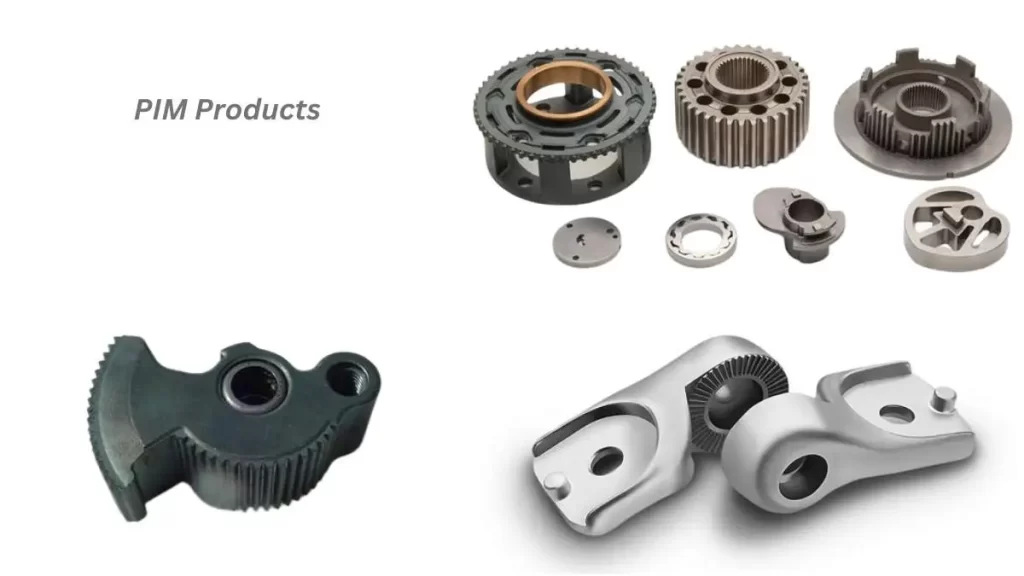
PIM products
Briefly, PIM has strength in small, intricate parts with detailed features and tight tolerances. The method has demonstrated its flexibility across diverse applications, including:
- Turbochargers and radial rotors silicon carbide for heat engines.
- Thread guides in alumina for application in textile equipment.
- Hard disc drives magnetic pole pieces of rare earth magnets.
- Electric toothbrush gears are made of stainless steel.
The examples mentioned above prove the potential of PIM to work with any type of material and industry, proving its ability to manufacture high-precision parts economically.
Influence of Raw Materials on the PIM Process
The current developments in PIM technology show the maturity of the technology, especially in controlling the nature of metal and ceramic powders to fit certain uses. Also, current binder systems have been enhanced to lower the defect level and shorten debinding time, which is a crucial aspect of part fabrication.
One possible factor that may enhance the use of PIM is the capacity to enhance component characteristics throughout production as opposed to after. This would provide improvement to surface characteristics: wear and corrosion resistance; as well as the volumetric characteristics: toughness. Some of the universities like Cranfield are already involved in researching means of enhancing the general performance of components right within the PIM process.
Powder Co-Injection Molding (PCM)
One innovation that may be noted here is Powder Co-Injection Molding (PCM) which provides the option to surface treat parts in situ. An example of the process is the use of two barrels, each feeding the same nozzle but injecting different materials into the mold in turns. This is done using a pneumatic valve system which enables control over the skin and core materials.
The process follows these steps:
- Placing the skin material into the mold, and then blowing it up.
- The outer layer is formed by skinning while injection of the core material is done after skinning is complete.
- The final shot of skin material completely covers the core of the sculpture.
During the process, the materials in each barrel may be different from one another. For example, the skin of 316L stainless steel can be combined with a carbonyl iron core. The cost variation between these materials is significant, thereby cutting production costs threefold. Manufacturers can also control the surface thickness layer by varying the ratio of the material injected from each barrel making the process cost-efficient. While at the same time achieving the required material property on the surface.
Furthermore, the secondary phases can be incorporated into the surface material to enhance its performance characteristics. For instance, adding alumina particles to the binder/powder combination for the skin increases its wear capability and makes it appropriate for high-stress applications. (Get more insights about Injection Molding Types)
Applications of Powder Injection Molding
Technological advancement in the powder injection molding industry is a breakthrough in contemporary manufacturing techniques. This innovative technique results in lightweight, highly durable, and at the same time versatile end-use products. Today this method is used in every industry to offer custom solutions to manufacturing needs.
Medical Instruments
Orthodontic brackets are core products of powder injection molding. PIM technology also makes it possible to fashion different types of medical instruments in detail. This way helps create intricate shapes of surgical instruments. Sustaining these applications’ durability and efficiency remains a primary focus in these applications.
Automotive Sector
Automotive components need special strength to perform in highly challenging conditions. PIM technology enables the creation of intricate parts for which durability is critical. It is used in automotive products such as engines and transmissions to guarantee the vehicle’s efficiency.
Electronics Industry
The Electronics sector requires precise and miniaturized components. Due to the high rate of technological development, PIM is highly competitive in producing such parts. This capability is illustrated by connectors and mobile device components. The method also improves the conduction features of electronic applications.
Aerospace
Components for aerospace applications must not be less dense but also have to be mechanically strong. PIM can satisfy these strict requirements using high-performance metals and ceramics. This method provides parts with high quality that meet the stringently required standards in aerospace engineering. Aircraft internal parts are usually made through powder injection molding.
Try Prolean Now!
Powder Injection Molding Vs. Metal Injection Molding
Powder Injection Molding (PIM) combines polymer injection molding
with other techniques of material processing. PIM and MIM are highly productive for manufacturing complex parts. These shared capabilities are now highly prized in industries that have a strong focus on intricate geometries.
Studied here are ceramics and metals that fall under the umbrella term of PIM. The process flexibility makes it possible to produce several different components for use in many different sectors. On the other hand, Metal Injection Molding(MIM) is specifically dedicated to manufacturing complex metal parts. Products produced from MIM normally possess characteristics comparable to those of wrought metals.
Whereas PIM is an all-purpose material process, MIM is an industry-specific one. A sound awareness of these differences helps manufacturers to choose the right technology.
Why ProleanTech is the Right Powder Injection Molding Company to Partner With?
Outsourcing your powder injection molding to Prolean Tech grants you over 10+ years of rich experience and knowledge in injection molding. Hiring our team ensures the design complexity and the variety of the materials used to create them are handled professionally to meet the highest industry standards of the final product.
In addition, Prolean Tech encompasses modern equipment and has highly confidential policies in place. We believe that reputation proves to be the best predictor of the quality and trustworthiness of a given company. It is our pleasure to state that our product has received much recognition from many users, clients, and customers, and has formed sound business relationships with our clients. Contact us now, and get instant injection molding quotes for your fabrication projects!

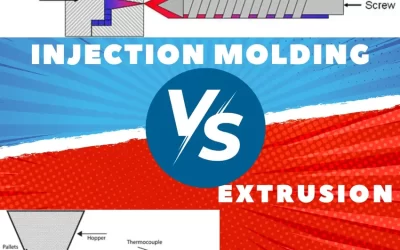
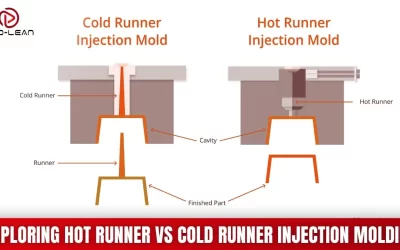
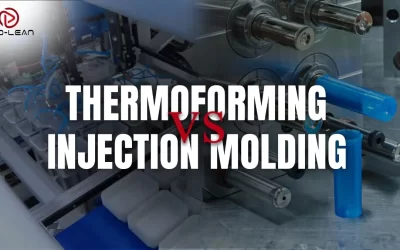
Thanks for this article. can you answer How does the binder material affect the final properties of the molded part in powder injection molding?
Hello, there. The binder plays a crucial role in the molding process. It helps bind the metal powders together during the molding stage, but it needs to be removed before sintering. The binder’s composition can influence the final part’s density, strength, and overall quality. Proper binder removal and sintering are essential to achieving optimal mechanical properties.